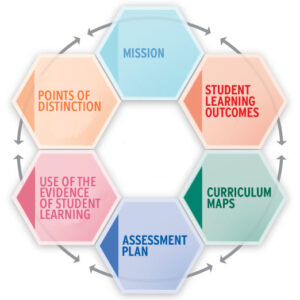
Welcome to Point Loma Nazarene University’s institutional assessment site. Our university is committed to the continuous improvement of our curricular (academic) and co-curricular areas by aligning our programs to the highest national standards in each respective discipline, annually assessing the gains in student learning, and making programmatic adjustments in order to achieve and exceed student success criteria. Assessing student learning is central to our educational quality assurance processes. In these webpages, you are invited to explore firsthand our serious commitment to demonstrating quality through our communities of assessment practices.
PLNU engages its faculty, staff, and students in an annual cycle of assessment where student learning is assessed in the appropriate course, assessment results analyzed, and adjustments and improvements to curriculum made. This full cycle from planning, assessment, and improvement is commonly called “Closing the Loop”. Our Annual Assessment Cycle for each curricular or co-curricular program culminating in the six-year Program Review with a Memorandum of Understanding (MOU) and Action Plan wherein assessment findings inform financial strategic planning. Our mission-focused, evidence-informed culture of decision-making starts with identifying a program’s unique missional objectives in tandem with the careful examination of each curricular or co-curricular unit’s alignment and contribution to the University’s mission and strategic plan framework.
Each academic major or co-curricular area has Program Learning Outcomes (PLOs) which identify exactly what students will know and be able to demonstrate in their chosen discipline upon graduation. These Program Learning Outcomes (PLOs) encompass the specific knowledge and skills which students are expected to acquire in preparation for graduate-level study or professional fields. These PLOs are measured and compared with national standards or other external benchmarks where appropriate, in addition to internal assessments of learning achievements using locally derived instruments. Additionally, each course has specific Course Learning Outcomes aligning the course to achieving the specific Program Learning Outcomes.
Each program has a Curriculum Map that identifies each of the courses required for the major and the Learning Outcomes for the program. Outcomes are embedded in courses and mapped across the whole curriculum. In academic units, the faculty identify where a specific learning outcome will be introduced, further developed, and finally mastered. All Program Learning Outcomes are assessed at the mastery level and in many cases will also be assessed at different formative stages during the program. The assessment of these Learning Outcomes forms the body of Evidence that faculty use to identify where the curriculum needs to be improved or strengthened.
Once the faculty identifies specific courses where Learning Outcomes are assessed, then a Multi-Year Assessment Plan, based on the annual assessment cycle and six-year Program Review, is designed to indicate where and when each Learning Outcome will be assessed using which signature assignments and rubrics. Rather than rely on a single assessment instrument, each Learning Outcome will be assessed in multiple ways. Direct measures of assessment may include student performing a skill or testing for specific knowledge identified in the Learning Outcomes. Indirect measures might include opinion surveys or student reflections. These various assessment assignments or surveys will be identified in the assessment plan and modified as required.
Evidence of Student Learning includes a range of assessment activities. For example, the Department of Art and Design includes a student’s art exhibition as a part of the senior culminating experience. In the School of Business, a professional portfolio offers a wealth of assessment information. In the Department of Biology, a student’s performance on the nationally normed ETS Major Field Test is a key piece of assessment data, and in the School of Theology and Christian MInistry, a student’s ability to prepare and delivery a sermon are direct assessments of Learning Outcomes appropriate to the disciplinary field.
The Use of the Evidence of Student Learning, the final step in “Closing the Loop,” illustrates how the assessment evidence and processes inform the faculty in making curricular changes to improve the program. Based on evidence derived through assessment, new programs and courses are created and others adjusted. Numerous examples of the Use of the Evidence of Student Learning elucidate how evidence derived from a well-developed culture of assessment has led PLNU to maintain the meaning, quality, and integrity of its curricular and co-curricular programs.
At the heart of every Assessment Wheel, each unit displays examples of student and faculty life that make their program both unique and a vital learning community. As our Assessment Wheels are continuously updated when new assessment information is collected and analyzed, we invite you to explore our resources and welcome your suggestions.
Current
Institutional Learning Outcomes